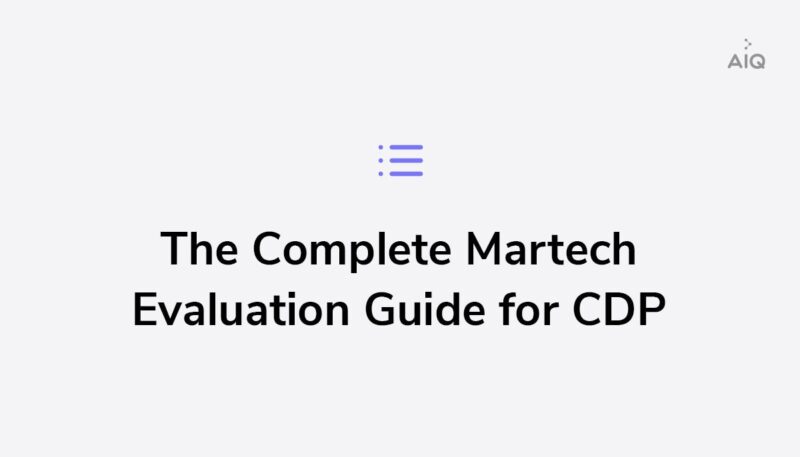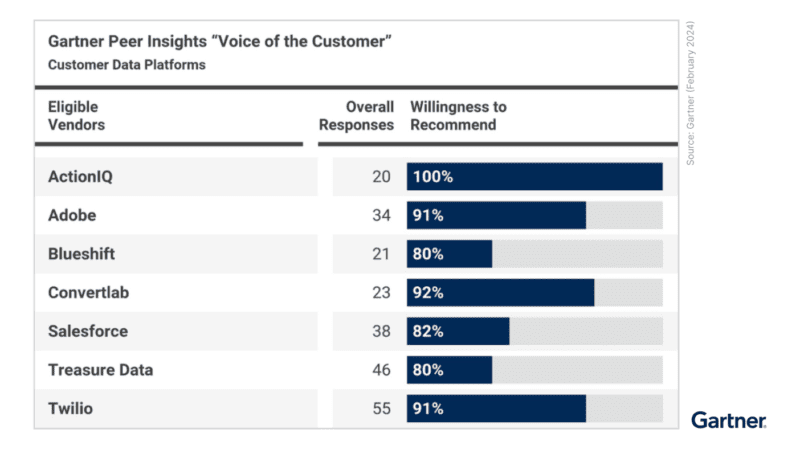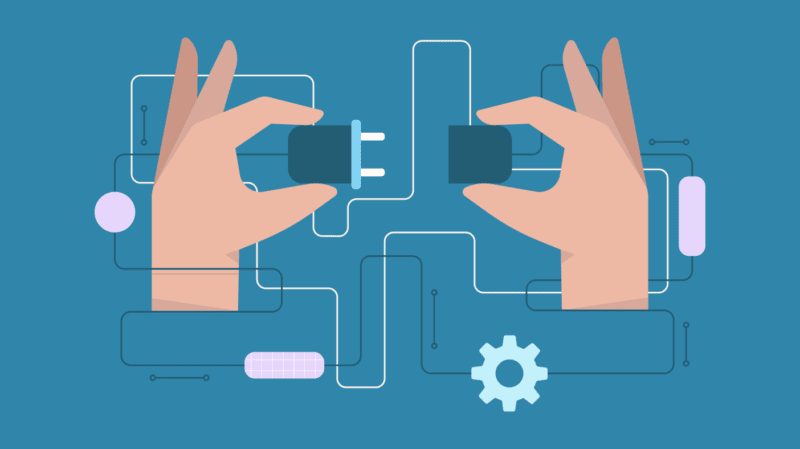Complete Martech Evaluation Guide for Customer Data Platforms

Here’s What You’ll Learn:
- Why choosing the right martech stack is critical for supporting your personalization strategy
- How to evaluate a CDP based on its ability to unify your data, analyze your customers, and activate personalized experiences at scale
- Best practices for selecting the right martech tools —and vendor partners—ideally suited to deliver on your unique goals
We Now Live in an Customer Experience Economy
80% of consumers say the experience a company provides is as important as its product or services. Now, more than ever, brands are looking at the marketing technology landscape to deliver hyper-personalized customer experiences. In order to compete and win on experiences, it is critical for brands to access and act on all their customer data with maximum speed, agility, and intelligence via technology.
Knowing Isn’t Enough—Brands Must Create Helpful Experiences
When creating truly personalized experiences, simply proving you know your customer is not enough: birthday emails and re-targeting abandoned carts are not the stuff of great experiences. A Gartner personalization study found that brands focusing on just knowing the customer see a 4% drop in commercial benefit.
Standalone experiences like these feel transactional and self-serv-ing to the brand, versus actually trying to help the customer. However, when brands go beyond just knowing their customers—to actually helping them—they create the type of experience that generates sustainable business value. The same Gartner survey found that brands that create helpful customer experiences see +20% commercial benefit.
Examples of helpful customer experiences include:
- Guiding customer engagement through a complex process (e.g. how to use a new product)
- Teaching customers something new (e.g. product care or complete the look)
- Rewarding customers (e.g. exclusive benefits when customers hit a goal)
A New Approach to Personalization at Scale
To exceed the expectations of today’s consumers—and meet the competitive challenges of today’s market landscape—brands must move beyond the status quo marketing strategy. Despite promises to the contrary, marketing cloud solutions, campaign managers, homegrown solutions, and other legacy approaches have fallen short of delivering on the imperatives for helpful, personalized experiences. These technologies were built to solve marketing goals that existed 10+ years ago.
This guide aims to define the key requirements and best practices of a CDP Evaluation.
Enter the customer data platform (CDP), a modern data-first approach to meeting the demands of today’s consumers. Brands and industry leaders are recognizing the foundational nature of the CDP in the modern marketing stack. In fact, McKinsey & The company recently placed CDPs at the center of its personalization strategy. At scale Martech stack—making CDPs the hub of customer-centric, data-driven growth transformation.
But transformational change within marketing operations is not easy. And the CDP market is extremely confusing. Most people are still trying to figure out the difference between CDP vs CRM.
So before embarking on your search for a CDP provider, it’s important to understand the core capabilities of a data platform solution—and how to determine which one is right for you. To help you conduct a more educated selection process for improving the customer journey, this guide aims to define the key requirements and best practices of a CDP evaluation.
Core CDP Capabilities
- Unify
- Unify and match all granular behaviors across online and offline channels, creating a single customer view
- Analyze
- Democratize insights, increase organizational agility, and augment human intelligence with AI
- Activate
- Orchestrate, test, and measure experiences across all customer touchpoints
- Infrastructure
- Provide a highly performant, secure, and scalable back end system to efficiently process all data workloads
Unify Your Data
Goal
A CDP serves as the single location for marketers to access the full history of detailed customer behaviors across all channels and touchpoints, online and offline. The unification layer is the engine of the CDP and is the most critical element in determining the effectiveness of all downstream capabilities and product features. A strong data foundation will enable your marketing team to go from idea to action up to 80% faster—giving you speed to market measured in hours rather than weeks and months.
How your data is ingested and stored will be the determining factor of whether you are able to deploy and achieve long-term value out of your CDP tech.
Challenge
On average, a marketer must access 15 different data sources. To get a complete customer view. These sources contain years of data spanning purchase information, browsing history, demographic information, email addresses, physical addresses, and more—all sitting in disconnected legacy systems, data warehouses, or data lakes that are not directly accessible to marketers.
Furthermore, each system has its own view of a customer and their identity, leading to disconnected experiences resulting from multiple “unique” IDs for the same customer. Unifying all that data using traditional systems is complex, time-consuming, and expensive. In practice, marketers end up only using a small percentage of all the customer data locked away in various systems.
Unify: CDP Requirements
| NEED | REQUIREMENTS |
| Collection Ingest and unify all online and offline customer data in real time and store persistently in your preferred cloud environment |
-Pre-built data connectors to all online and offline sources -Ability to ingest unstructured data in the original source format -Unlimited data storage of all raw customer events -Automated data quality validation monitoring and notofications |
| Matching Resolve, authenticate and dedupe customer records through configurable, deterministic and probabilistic matching techniques |
-Cross-source deterministic user matching (e.g. name, email etc.) -Probabilistic machine learning- based matching techniques -Ability to configure matching techniques and monitor performance |
Analyze Customer Behaviors
Goal
Organizational agility and intelligence directly impact your ability to deliver helpful experiences. A CDP provides business users with an intuitive interface to access insights, both their own and machine-driven, and to iterate on experiences on-the-fly—all without ever having to call the vendor or IT. An analytics layer combined with a strong data foundation is proven to increase the impact of your personalization efforts by 2X.
An analytics layer combined with a strong data foundation is proven to increase the impact of your personalization efforts by 2X.
Challenge
Customer data is complex and messy, forcing most marketers to request strapped analytics and IT teams to manually pull audience counts, update customer segments, and run models. This process can take days or weeks, leaving marketers very little room to explore or iterate on new ideas—slowing time to market, limiting creativity, and ultimately creating generic customer experiences that hurt business goals.
Analyze: CDP Requirements
| NEED | REQUIREMENTS |
| Usability Enable business users to self-serve insights, audiences and activation needs within defined permissions and governance controls |
– Configurable admin UI for managing user permissions and data controls – Single drag and drop user interface for all CDP features and tasks -SQL like UI to define and manage customer attributes on-the-fly |
| Intelligence Run advanced analytics and operationalize ML-based models across the entire history of customer behaviors |
– Real-time analytics across unlimited customer behaviors and history – Native ML-based models that can be configured to custom business rules – Host and operationalize data science models developed outside of the platform |
Activate Personalized Experiences
Goal
Data and analytics are only valuable once they are activated into personalized customer experiences. A CDP activates the delivery and measurement of helpful experiences across every channel customers interact with your brand. Directly integrated with data and analytics, the activation layer orchestrates and improves experiences through iterative experiments and ML-powered optimization. All leading 20% lift in business outcomes.
A CDP activates the delivery and measurement of helpful experiences across every channel customers interactation with your brand.
Challenge
Brands struggle with disjointed execution processes across channels, because they lack a common layer connecting all of them. As a result, marketing teams must undertake one-off, manual efforts to upload audiences and data into each channel, each with its own format and integration requirements. This effort makes any real coordination across channels all but impossible, resulting in fragmented customer experiences and an inability to test or measure holistic results
Activate: CDP Requirements
| NEED | REQUIREMENTS |
| Orchestration Orchestrate and prioritize customer journeys across all offline and online channels, in real time, from a single UI |
-Pre-built integrations to all online and offline channels used for marketing and customer experience – Provide a unified customer view to any upstream or downstream channel – Data and channel agnostic customer journeys combined with real-time contextual triggers |
| Optimization Run and measure multi-dimensional tests; apply machine learning to experiences; measure business impact |
-A/B testing and measurement via custom business KPIs – Optimize contact priority and frequency across all channels, from a single interface – ML-based self optimizing journeys and customer affinity scoring |
Enterprise-Grade Infrastructure
Goal
Brands seeking to transform the customer experience have high standards for governance, privacy, security, system reliability, and performance. The CDP must prove it can meet these standards while also detailing how it can integrate seamlessly with existing organizational structures and your marketing ecosystem.
A CDP must meet standards for governance, privacy, security, system reliability, and performance
Challenge
As a new marketing technology, most CDP’s lack maturity when it comes to delivering on the requirements typically expected of enterprise-class systems, especially where it comes to interoperability, trust, scalability, reliability, governance, and permissioning. Be sure to run through these requirements with CDP providers to
validate they meet the needs of your enterprise.
Infastructure: CDP Requirements
| NEED | DESCRIPTION |
| Hosting | Proprietary data infrastructure able to deploy across any cloud environment |
| Teams & Roles | Configurable platform controls to manage multiple teams and user types across the organization |
| Data Governance | Configurable platform controls to manage data access and usage permissions across teams and users while providing a single source of truth across the organization |
| PII | Platform Compliance with General Data Protection Regulation (GDPR), California Consumer Privacy Act (CCPA), Privacy Shield and other PII-related Standars |
| Security | SOC2 Type 2 compliant system employing data encryption at rest and in motion, user access controls, multi-factor authentication, and network firewalls |
| Monitoring | Automated data pipeline monitoring, proactive alerts, and diagnostic toolsfor when failures do occur |
Best Practices for Your CDP Evaluation
Marketing technology alone will not get you to where you need to be, which means you must consider the complete solution when evaluating CDP vendors. Many vendors may sound the same and may even claim to have the same capabilities, which is why it is important that you prioritize and press for details on the most important criteria. Consider these core best practices to reduce risk and increase the likelihood of successfully onboarding your CDP.
- Prioritize your data foundation
- It won’t show up in the demo, but data collection is the most important CDP capability to drive agility and intelligence.
- Define your use cases
- Pick quick wins to show value early, and strategic use cases to define the long-term vision.
- Map your capability gaps
- Understand what capabilities you are missing and which are most important to closing use case gaps.
- Vendors do many things but can be only great at one
- Look at the vendor’s history and pedigree; be aware of product category pivots.
- Find clients who look like you
- Vendors solving similar problems at clients that look like you (or you aspire to look like) is the best way to evaluate fit; use reference calls to confirm they are solving the same problem.
- Understand the support model
- Underestimating the value and need for hands-on customer support for implementation and ongoing needs is a common pitfall.
- Don’t wait
- Don’t let perfect get in the way of good enough, this is a journey and the longer you wait the harder it will be to complete. Still confused on what exactly a CDP is or what the difference between a CDP vs DMP vs CDI? Be sure to check out all of our other blog articles that goes in-depth into the key differences.





